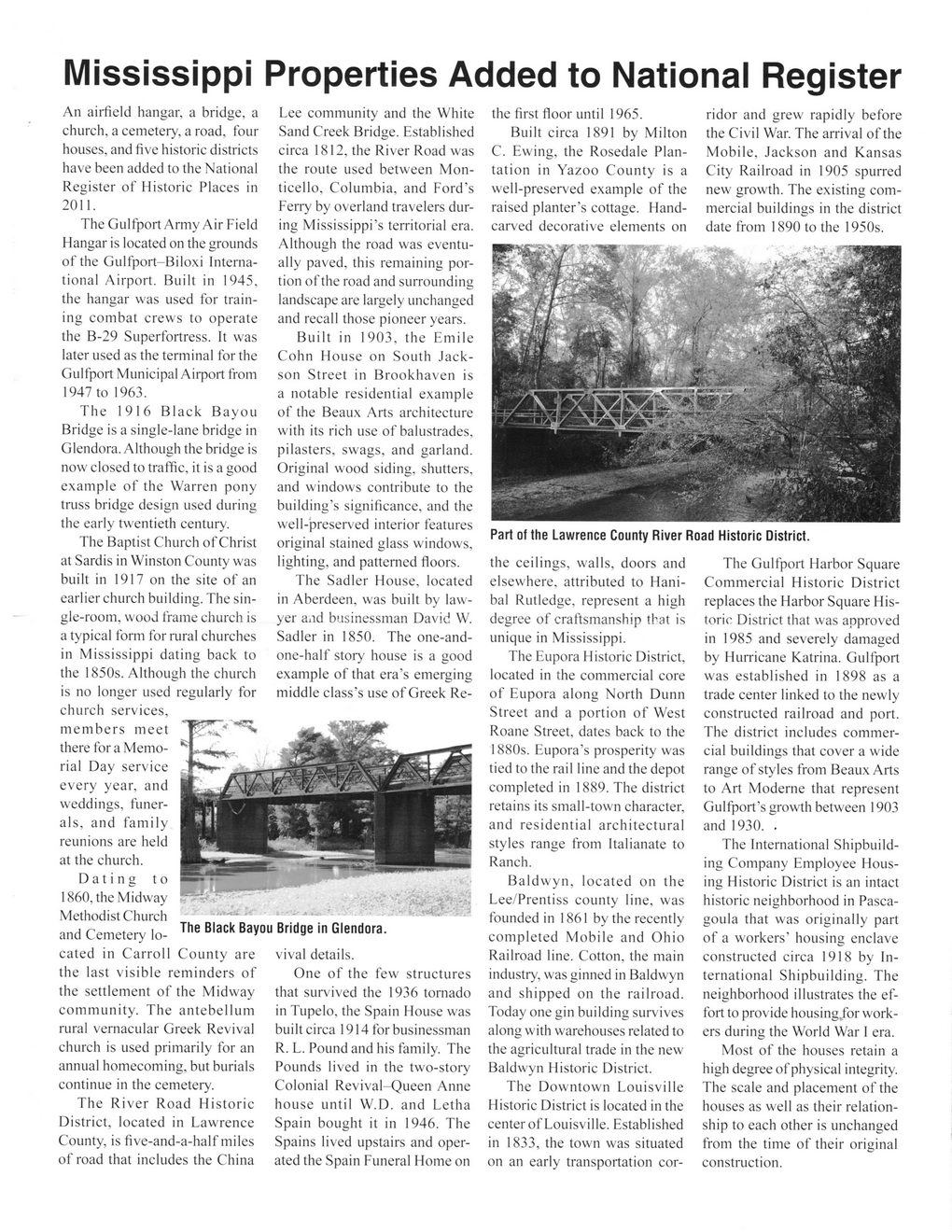This text was obtained via automated optical character recognition.
It has not been edited and may therefore contain several errors.
Mississippi Properties Added to National Register An airfield hangar, a bridge, a church, a cemetery, a road, four houses, and five historic districts have been added to the National Register of Historic Places in 2011. The Gulfport Army Air Field Hangar is located on the grounds of the Gulfport-Biloxi International Airport. Built in 1945, the hangar was used for training combat crews to operate the B-29 Superfortress. It was later used as the terminal for the Gulfport Municipal Airport from 1947 to 1963. The 1916 Black Bayou Bridge is a single-lane bridge in Glendora. Although the bridge is now closed to traffic, it is a good example of the Warren pony truss bridge design used during the early twentieth century. The Baptist Church of Christ at Sardis in Winston County was built in 1917 on the site of an earlier church building. The single-room, wood frame church is a typical form for rural churches in Mississippi dating back to the 1850s. Although the church is no longer used regularly for church services, members meet there for a Memorial Day service every year, and weddings, funerals, and family reunions are held at the church. Dating to 1860, the Midway Methodist Church and Cemetery located in Carroll County are the last visible reminders of the settlement of the Midway community. The antebellum rural vernacular Greek Revival church is used primarily for an annual homecoming, but burials continue in the cemetery. The River Road Historic District, located in Lawrence County, is five-and-a-half miles of road that includes the China Lee community and the White Sand Creek Bridge. Established circa 1812, the River Road was the route used between Mon-ticello, Columbia, and Ford’s Ferry by overland travelers during Mississippi’s territorial era. Although the road was eventually paved, this remaining portion of the road and surrounding landscape are largely unchanged and recall those pioneer years. Built in 1903, the Emile Cohn House on South Jackson Street in Brookhaven is a notable residential example of the Beaux Arts architecture with its rich use of balustrades, pilasters, swags, and garland. Original wood siding, shutters, and windows contribute to the building’s significance, and the well-preserved interior features original stained glass windows, lighting, and patterned floors. The Sadler House, located in Aberdeen, was built by lawyer and businessman David W. Sadler in 1850. The one-and-one-half story house is a good example of that era’s emerging middle class’s use of Greek Re- vival details. One of the few structures that survived the 1936 tornado in Tupelo, the Spain House was built circa 1914 for businessman R. L. Pound and his family. The Pounds lived in the two-story Colonial Revival-Queen Anne house until W.D. and Letha Spain bought it in 1946. The Spains lived upstairs and operated the Spain Funeral Home on the first floor until 1965. Built circa 1891 by Milton C. Ewing, the Rosedale Plantation in Yazoo County is a well-preserved example of the raised planter’s cottage. Hand-carved decorative elements on the ceilings, walls, doors and elsewhere, attributed to Hani-bal Rutledge, represent a high degree of craftsmanship that is unique in Mississippi. The Eupora Historic District, located in the commercial core of Eupora along North Dunn Street and a portion of West Roane Street, dates back to the 1880s. Eupora’s prosperity was tied to the rail line and the depot completed in 1889. The district retains its small-town character, and residential architectural styles range from Italianate to Ranch. Baldwyn, located on the Lee/Prentiss county line, was founded in 1861 by the recently completed Mobile and Ohio Railroad line. Cotton, the main industry, was ginned in Baldwyn and shipped on the railroad. Today one gin building survives along with warehouses related to the agricultural trade in the new Baldwyn Historic District. The Downtown Louisville Historic District is located in the center of Louisville. Established in 1833, the town was situated on an early transportation cor- ridor and grew rapidly before the Civil War. The arrival of the Mobile, Jackson and Kansas City Railroad in 1905 spurred new growth. The existing commercial buildings in the district date from 1890 to the 1950s. The Gulfport Harbor Square Commercial Historic District replaces the Harbor Square Historic District that was approved in 1985 and severely damaged by Hurricane Katrina. Gulfport was established in 1898 as a trade center linked to the newly constructed railroad and port. The district includes commercial buildings that cover a wide range of styles from Beaux Arts to Art Moderne that represent Gulfport’s growth between 1903 and 1930. . The International Shipbuilding Company Employee Housing Historic District is an intact historic neighborhood in Pascagoula that was originally part of a workers’ housing enclave constructed circa 1918 by International Shipbuilding. The neighborhood illustrates the effort to provide housing.for workers during the World War I era. Most of the houses retain a high degree of physical integrity. The scale and placement of the houses as well as their relationship to each other is unchanged from the time of their original construction. Part of the Lawrence County River Road Historic District.

Mississippi History Newsletter 2011 Winter (6)